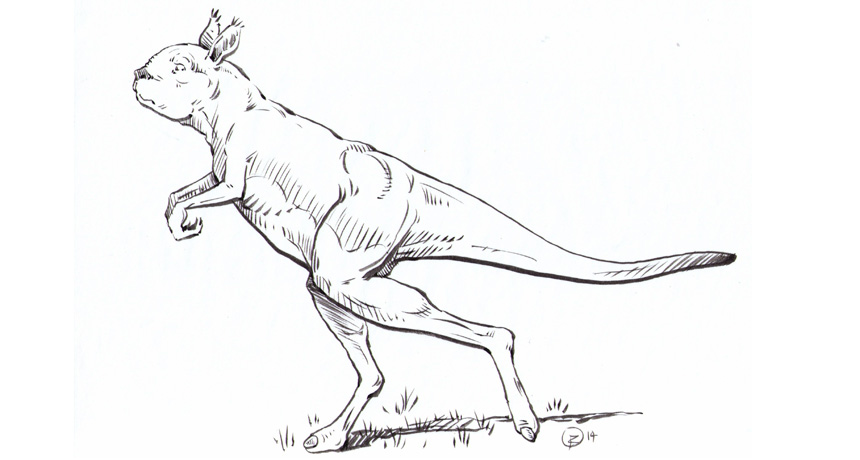News Brief: No hopping for these ancient ‘roos
Unlike their smaller, modern cousins, these giant kangaroos walked upright on their back feet

This extinct supersized kangaroo probably tiptoed on one hind leg at a time instead of hopping, a new study concludes.
C.M. Janis et al/ PLOS ONE 2014
By Susan Milius
The real hulks among extinct kangaroos probably didn’t hop. They tiptoed on one rear leg at a time, a new study concludes.
As recently as 30,000 years ago, the kangaroo family tree included a now-extinct branch. Its members were known as Sthenurines (Sthen-YOUR-eens). Some were small, others true whoppers. The largest could have tipped the scales at a massive 240 kilograms (roughly 530 pounds). That’s twice as much as a typical full-sized American refrigerator. It’s also far heavier than today’s biggest ‘roos. Males of the largest living kangaroo species, for instance, average 55 kilograms, although some may run as much as 90 kilograms.
Christine Janis is a functional anatomist and paleontologist at Brown University in Providence, R.I. She and two other scientists analyzed bones from 78 sthenurines. They represented a range of sizes. The size, weight and linkage of the bones in these species now suggest that the prehistoric big daddies would not have jumped. Instead, they would have walked on two feet.
Among the clues: The giant roos’ bones hint at a body too heavy for frequent hopping. Their hips also flared out with plenty of room for attaching big gluteal muscles, Janis says. Those muscles would have been similar to the ones that help people balance on one leg while stepping forward with the other. The scientists describe their findings in the October 15 PLOS ONE.
Despite their reputation for hopping, today’s kangaroos actually spend much of their day walking on all fours. They even use their tails like a fifth leg. (With their front feet planted on the ground, they balance on their tail as they swing their hind legs forward.) Spines of the biggest sthenurines, however, look too stiff for this kind of motion, Janis and her colleagues report.
Still, the ancient, snub-faced mega-roos would not have lumbered along like a Godzilla. Modern kangaroos hop on the ends of their feet. Janis expects their giant ancestors, too, would have moved on tiptoe.
Power Words
anatomy The study of the organs and tissues of animals. Scientists who work in this field are known as anatomists. A subset of these scientists study how the organ systems worked and related to one another. They may be referred to as functional anatomists.
extinct An adjective that describes a species for which there are no living members.
gluteal Relating to the large muscles in an animal’s buttocks. In people, the outermost of these muscles is called the gluteus maximus.
muscle A type of tissue used to produce movement by contracting its cells, known as muscle fibers. Muscle is rich in a protein, which is why predatory species seek prey containing lots of this tissue.
paleontologist A scientist who specializes in studying fossils, the remains of ancient organisms.
Sthenurines A family of kangaroos that lived up until about 30,000 years ago. Member species ranged broadly in size. The largest would have been at least three times the size of the largest living kangaroo today. And unlike modern kangaroos, the biggest of the Sthenurines likely walked — one foot before the other — on their two hind legs.







